Welcome to Miguel Alonso Amelot webpage,
and find what can be done in science by combining organic chemistry, biology of plants and animals, under an ecological perspective.
PAGE CONTENTS PERSONAL DATA: higher education and things
CAREER OVERVIEW, birds eye sight
CURRENT AND PAST RESARCH PROJECTS,
highlights, published reports, PDFs

circa 2006

circa 2013
2016
BASIC PERSONAL DATA
Born in Caracas, Venezuela 1946
Nationality Venezuelan and Spaniard
Currently lives in Spain
Contact: alonsome123@gmail.com
PUBLICATIONS
About 100 academic papers in internatl journals (1277 citations Thomson Reuters Web of Science), 5 books, several book chapters (see list of publications)
HIGHER EDUCATION.
BSc. (Licenciatura) in Chemistry, Universidad Central de Venezuela, Caracas, October 1968PhD. (Chemistry), Indiana University, Bloomington, Indiana, USA. February 1975
Post Doctorate: Cornell University, Department of Chemistry, Ithaca, New York, 1983-4
ACADEMIC POSITION (1986-2014)
Full professor of organic, bioorganic and ecological chemistry, - Department of Chemistry, Faculty of Sciences, Universidad de Los Andes, Mérida, Venezuela
Current (2016): Professor Emeritus, (active retirement) (I apologize for the oximoron)
Independent advisor in bioorganic chemistry, bioactive natural products with applications to human and animal health.
Research Collaboration in bracken fern chemistry and biology with Universidad de Valencia (Spain) and other research groups in the bracken area,
Wiki writer on advanced organic chemistry, reaction mechanism problems See.
http://organic-room-1.wikispaces.com/
Writer with several short stories published in Spanish and one book collection.
BEFORE 1986 (precambric times. that is):
Research and teaching positions at IVIC, Instituto Venezolano de Investigaciones Científicas, Departamento de Química Caracas, Venezuela 1969-1986
Temporal tenure at Illinois State University, Normal, Illinois, USA, 1992-3
After almost 50 years in academia, i's a bit boring and of no interest to anyone to give further details.
CURRENT ACADEMIC INTERESTS
General: Bioorganic, ecological and nutraceutical chemistry
Specific:
Organic ecotoxicology in the human/animal-food interface
Organic chemistry of food safety and health issues
Nutraceutical formulation and development
CURRENT POSITION
Free lance advisor on subjects above
Science writer – articles, books
Reviewer of scientific manuscripts for:
John Wiley & Sons (>2013)
Journal of Agricultural and Food Chemistry (>2010)
Journal of Food Composition (>2012)
Journal of Food Science (>2012)
Chemistry and Ecology (>2013)
Environmental Toxicology & Chemistry (>2013)
Animal Feed Science & Technology (<2015)
Bioactive Natural Products (Book chapters)

PANORAMIC VIEW OF MERIDA CITY, VENEZUELA - SIERRA NEVADA IN THE BACKGROUND.
A quick overview
Most people are short of time. All they want from Internet is to get a quick view of everything, as fast and short as possible. I have tried to do that here without much success. No one can put together a life-long experience in research with over one hundred academic papers, a handful of books, web pages and all the experience and collaboration of others supporting all this in just a few words without jumping into the pitfall of superficiality.
So, if you do not have time, stop reading and go back to whatever you were doing. After all you can all live a successful life without knowing who I was or what I did in my time up to now.
But if you feel curious to learn something from someone capable of saying this, of accusing modern society of bleak superficiality and all that fastidious lot, then read on.
I'll begin by introducing me as the result of a mixture between inherited genes, good and bad decisions, and circumstances, some of them positive, others just the opposite, beyond my own control.
My academic life and performance is divided in two main segments:
1) 1970-1990 or just about: Organic chemistrry the hard way. Organic reactions, synthesis, physical chemistry, reaction mechanism
2) Chemical ecology, from insects and plants to their impact in animals and people as carcinogenic agents
I have spent the last 60 years of my life, that is nearly 90% of it, in fantastic tropical environments of northern South America. Venezuela to be specific. The last 25 years in Mérida, (picture above), among high Andean mountains. This feature is of relevance since there are several life zones according to Holdridge. Venezuela is one of these biodiverse countries one hears about in TV documentaries with dozens of life zones that still conceal most of their potential, a real quarry for scientific discovery. At Universidad de los Andes a few research groups in biology, ecology, geography and chemistry have explored this territory leading to interesting discoveries about the inner workings of Nature in the Northern Andes and some cases of negative impact on local cattle husbandry and health issues stemming from wild plant consumption. This is us.
However, lack of official effective enforcement of reams of environmental protection laws, population increase and political populism has led to various borders of conflict between an expanding population moving against pristine landscapes of virgin forest and savannas. This bordeline or ecotone, in turn, creates a highly dynamic frontier where indigenous and foreign plant species come and go, in contrast with well established and protected forest, scrub, savanna and mountainous habitats encompasing thousands of square kilometers of bioreserves and species of plants, birds and invertebrates.
This area is a true quarry for scientific exploration if you manage to find the $$ resources, high quality associates and enthusiastic students to do it. I found a good deal of the last two at Universidad de Los Andes (ULA), in beautiful Mérida. As for $$, well, we all complain, don't we? But political unrest fueled by government populist policies, ruinous handling of petroleum riches and highwire corruption brought havoc and disaster to the scientific community among other victims. In spite of this, I carried on with my work elsewhere (Spain) as emeritus of ULA in the hopes that a new generation of talented students, hardened by the harsh circumstances, will learn from our continued work and rescue the lead so sadly lost in the past decade.
A preliminary description of our discoveries and published articles, about 100 at this point, that our group of scientists and students have produced at Grupo de Química Ecológica (GQE) follows in inverse chronological order. As well as, EDUCATIONAL PROJECTS are currently on stage and run in parallel with the rest.
RECENT PROJECTS (individal description below)
Bracken fern (Pteridium species), ecochemistry of toxic components, impact on cancer
Bracken, growth and ecological impact
Eco-etiology of human gastric cancer and animal diseases
Carcinogens vs nutraceuticals in food based health issues
Ecochemistry of plant phenolics
Chemical ecology of cyanogenic plants
Adaptation mechanisms of high elevation plants in the Andean Paramo.
APPLIED PROJECT: Conservation of stored cereals in the tropics with botanical insecticides.
Nutraceutical product development from South American plants
EDUCATIONAL PROJECTS
The SELF-ORG-CHEM INITIATIVE - click HERE for details
Organic reaction mechanism problems - click HERE for details
BRACKEN FERN: Ecochemistry of toxic components
This is the only subject described here among the several others I have researched in the last 20 years or so. Bracken is a vastly interesting organism, and several reviews and book chapters have been devoted to this plant. I will describe only what our work touches upon, making reference to others work whenever necessary. Read on to have an overview.
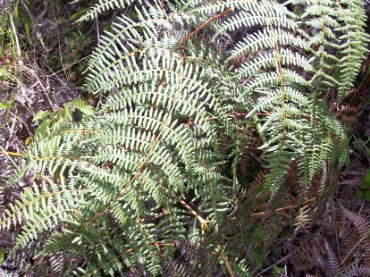
Bracken (Pteridium arachnoideum) fronds in Mérida, Venezuela

Bracken rhizomes extending from the thicket in the background into a fallow field already invaded by Rumex acetosella, another serious agricultural weed. Eventually bracken will out compete Rumex as its rhizome occupies a deeper soil layer. Frond cover will intercept 95% of incident sunlight displacing most heliophile species. Photos by M. Alonso
OVERVIEW:
Bracken ferns (genus Pteridium Gled ex Scop., Dennstaedtiaceae family) are true agricultural pests. Robust, fire resistant, fast growing thickets plants become encroached in a wide variety of climates and elevations developing a resistant rhizome that penetrates deep into the soil.
Bracken is a subcosmopolitan plant (meaning that it grows in all continents except Antartica and desert lands) and has become one of the five most prevalent and land damaging weeds in the world. Besides, it is resistant to most insects, vertebrate herbivores avoid it and is also toxic. It kills cattle by way of acute intoxication or through a raft of chronic pathologies including urinary bladder cancer.
Bracken is one of the few plants naturally inducing cancer in animals. The compound responsible for this, ptaquiloside, an illudane type nor- sesquiterpene, is known since 1984, when it was isolated byJapanese scientists, Iwao Hirono and coworkers.
Ptaquiloside has been shown to form covalent adducts with nucleosides, chiefly adenine and guanine, and DNA as well. DNA responds to this alkylation by depurination and strand breakage. Comet assays of exposed tissue in mice reveal DNA strands caused by bracken extracts and sporesThis means that eating bracken is likely to severely damage your DNA.
HIGHLIGHTS
1) The concentrations of Ptaquiloside and other toxins including prunasin (a cyanogenic glycoside) and additional compounds such as pterosins A, B and Z of the 1-indanone type, in fronds vary in a 1:20 ratio as the aerial parts mature from early croziers to fully grown fronds.
2) Mid-size fronds, which are still soft and palatable, typically contain 300 mg to 1 g of carcinogenic ptaquiloside per kg (dry). However, ocassionally mature fronds have been reported with as much as 13 g/kg of ptaquiloside. A true chemical bomb!
2) Ptaquiloside is not the only illudane toxin in neotropical brackens (Pteridium caudatum and P. arachnoideum).We have discovered four additional homologs with carcinogenic potential, iso-ptaquiloside, caudatoside, ptaquiloside Z and pteridanoside, the latter being a proto-illudane with a four membered ring. Recently an additional illudane (Esculentoside) was isolated from Australian Pteridium esculentum.
3) Caudatoside may occur also in large quantity even surpassing the amount of ptaquiloside in P caudatum, thus increasing the carcino-genic potential.
4) We discovered that cows exposed to ptaquiloside bracken excrete part of the carcinogen (about 8%) through their milk. For large scale milk production this represents a low risk of cancer induction in consumer people because of the large dilution effect when clean and tainted milk lots are mixed.
However, in small scale cattle husbandries where part of the milk and dairy products are consumed by tenant families, the cancer risk is increased considerably. Our model estimates a ptaquiloside load of 2.5 mg of the carcinogen per liter of milk.
Calves allowed to feed on mothers fed bracken develop symptoms of bracken poisoning.
Ptaquiloside is a thermally unstable compound, decomposing to non toxic pterodin B. However, boiling milk shortly (5 min) does not furnish but a moderate reduction of the ptaquiloside concentration.
Recent, still unpublished data from our lab shows that caudatoside, a potentially carcinogenic illudane because of its likeness to ptaquiloside, is also present in P. caudatum fronds in similar amounts than the parent compound.
Alonso-Amelot, M. E., Pérez-Mena, M., Calcagno, M. P., Jaimes, R. Quantitation of pterosins A and B and Ptaquiloside, the main carcinogen or Pteridium aquilinumby high pressure liquid chromatography . Phytochemical Analysis 3: 160-164 (1992)
Alonso-Amelot, M. E., Pérez-Mena, M., Calcagno, M. P., Jaimes, R. Ontogenic variation of biologically active metabolites of Pteridium aquilinum in a bracken population of the tropical Andes. Journal of Chemical Ecology 18: 1405-1420 (1993)
See also:
Alonso-Amelot et al. Biochemical Systematics & Ecology 23: 709-716(1995)
Castillo, U., Wilkins, A. L. Lauren D. R., Smith, B. L., Towers, N. R., Alonso-Amelot, M. E., Jaimes Espinoza, R. Structure elucidation of isoptaquiloside and caudatoside, new illudane type sesquiterpene glucosides from Pteridium aquilinum var caudatum. Phytochemistry 44: 901-906 (1997)
There are interesting contributions from others in this field which are referenced extensively in my articles. You are welcome to find these there
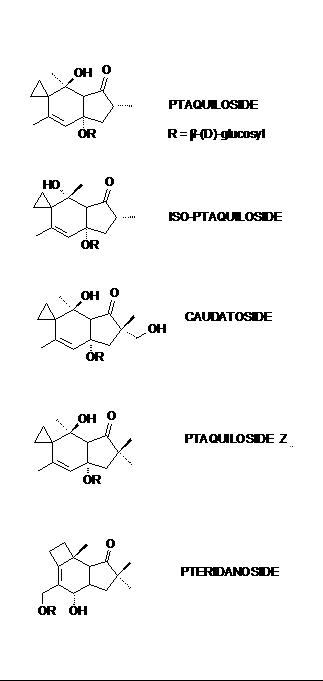
Molecular structures of illudanes found in Pteridium caudatum from Merida, Venezuela. Quantitative analysis and spectral details in:
Alonso-Amelot, M. E., Pérez-Mena, M., Calcagno, M. P., Jaimes, R. Quantitation of pterosins A and B and Ptaquiloside, the main carcinogen or Pteridium aquilinumby high pressure liquid chromatography . Phytochemical Analysis 3: 160-164 (1992)
Alonso-Amelot, M. E., Pérez-Mena, M., Calcagno, M. P., Jaimes, R. Ontogenic variation of biologically active metabolites of Pteridium aquilinum in a bracken population of the tropical Andes. Journal of Chemical Ecology 18: 1405-1420 (1993)
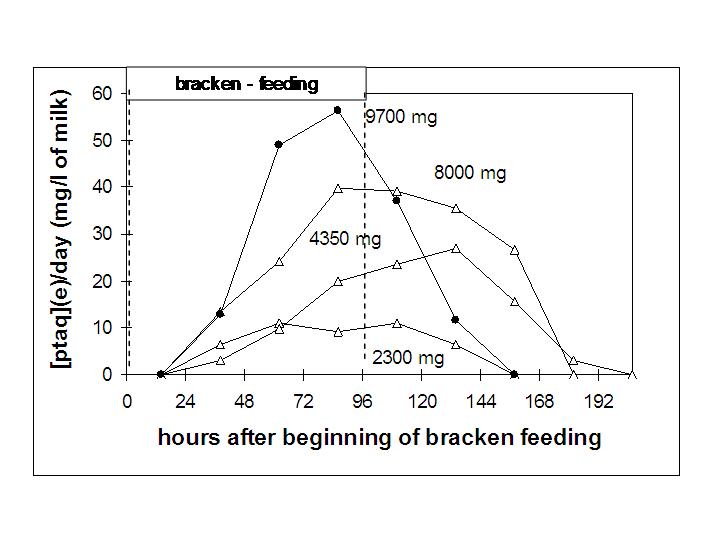
Variation of ptaquiloside concentration relative to feed intake in milk from cows fed fresh bracken (P. caudatum) fronds. Data from our Nature, 1996 paper.
Alonso-Amelot, M. E., Castillo, U., De Jongh, F. Passage of bracken fern carcinogen into milk. Lait, 73: 323-332 (1993)
Alonso-Amelot, M. E., Castillo, U., Smith, B. L., Lauren, D. R. Bracken Ptaquiloside in Milk. Nature 382:587-88 (1996)
--- Nutrition 13: 694-696 (1997)
Alonso-Amelot, M. E., Castillo U., Smith, B. L., Lauren, D. R. Excretion through milk of ptaquiloside in bracken-fed cows. A quantitative assessment. Lait 87:413-423 (1998)
Castillo, U., Ojika, M., Alonso-Amelot, M. E., Sakagami, Y. Ptaquiloside Z, A new toxic sesquiterpene glycoside from neotropical bracken fern Pteridium aquilinum var caudatum. Bioorganic & Medicinal Chem. 6: 2229-2233 (1998)
Castillo, U., Ojika, M., Alonso-Amelot, M. E., Sakagami, Y. Pteridanoside, the first protoilludane sesquiterpene glycoside as a toxic component of the neotropical bracken fern Pteridium aquilinum var caudatum. Tetrahedron 55: 12395-12300 (1999)
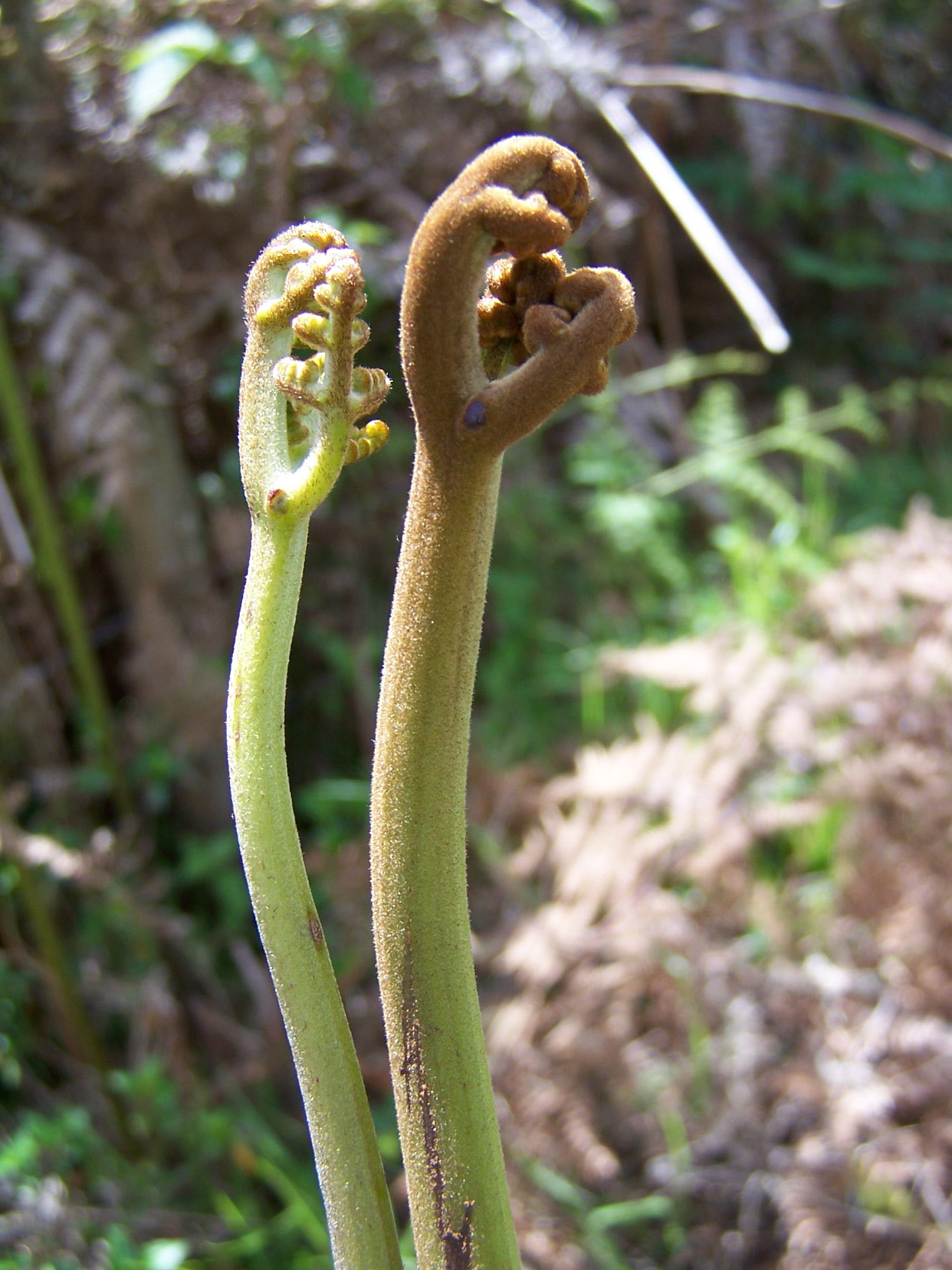
Young croziers of Pteridium caudatum (left) and P arachnoideum from Merida, Venzuela. Photo: M. Alonso

HCN released from young P. arachnoideum crozier parts as a funcion of time after squashing at 24ºC. Data from Alonso-Amelot & Oliveros, 2005.
CYANOGENESIS IN BRACKEN
Brackens may contain prunasin, a cyanogenic glycoside in substantial amounts. This compound is stored in the vacuole but possibly in the cytosol as well. As the prunasin - HCN catalyzing enzyme, prunasinase, is also present although in a different cell compartment (cell wall), HCN is released when cells are squashed during tooth grinding. HCN and benzaldehyde are produced in equimolar amounts from prunasin, both acting as xenobiotics on the feeding animal, be it chewing insect or vertebrate herbivore. As prunasin is intensely bitter, all three compounds will deter higher herbivores with bitterness sensitive tastebuds and and a negative reaction to this flavor.
Prunasin and total cyanogenic potential varies with frond ontology: recently emerged croziers and soft meristems of developing fronds accumulate the largest concentration whilst the mature frond is practically devoid of prunasin.
We have developed techniques for measuring rates of HCN release in cyanogenic plant tissue. In bracken, rates vary with frond age and frond part. Soft buds are much more active than harder sections of fronds. Also the soft tip of croziers are more active than stype sections under it. The plot at left shows the HCN evolution rate change with time in head, upper stype and lower stype of young croziers. Nearly 120 micrograms of cyanide per min may be released into the attacker's mounth parts or foregut in the first minutes of feeding. This property may have profound effects on the receptor including severe acute intoxication.
Bracken is polymorphic in its cyanogenic expression. While the majority of P caudatum in the northern Andes is acyanogenic, the large majority of P. arachnoideum is strongly cyanogenic at the crozier stage, which rapidly wanes with growth. Amount and rate of HCN produced may reach levels sufficient to kill small mammals, and cause malaise and encephalomalasia in sheep. Benzaldehyde produced as a by-product may contribute to intoxication.
Alonso-Amelot M. E., Oliveros, A. A method for the practical quantification of cyanogenesis in plant material Phytochemical Analysis 11(5):309-316 (2000)
Alonso-Amelot M. E., Oliveros A. Kinetics of the natural evolution of hydrogen cuanide in neotropical Pteridium arachnoideum and its ecological significance. Journal of Chemical Ecology 31: 315-331 (2005)
Oliveros-Bastidas, A., Alonso-Amelot, ME. Cyanogenic polymorphism in brackens: Pteridium arachnoideum and P caudatum from the northern Andes. Quim Nova 33: 1520-1524 (2010)
BRACKEN AND CANCER
That bracken secondary metabolites include illudanes, which under laboratory conditions induce several pathologies in test animals related some of them to cancer does not necessarily mean that exposure to bracken fields increases the risk of developing cancer in farm animals and people. One requisite must be satisfied: that bracken parts enter the human/animal body, either on purpose or by accident.
There are three ways:
1) Breathing spores in bracken infested fields during spore production season (end of summer, or dry season). Such exposure would be an increased risk of lung cancer. This has not been recorded yet.
2) Illudane glycosides are water soluble. Rasmussen and Hansen in Denmark have shown that ptaquiloside is leached by rain into soil and ground water. The carcinogen remains without much decomposition for some time, enough for this contaminated water to reach municipal water supplies. Cancer risk, gastric in this case, has not been assessed among people living in bracken infested watersheds. Epidemiological studies would be desirable.
3) Bracken carcinogens enter the animal/human diet. Indeed, bracken parts are eaten after a quick pretreatment during which most of ptaquiloside remains in plant tissue. Brazilians of the city of Ouro Preto (among consumers in Japan, China, New Zealand and other countries) who consume bracken croziers show higher gastric cancer rates (odds ratio: 5.5) than non consumers. This figure is highly signifficant.
We have demonstrated that milk is another route of ptaquiloside into calfs and human diet. We have performed epidemiological studies on gastric cancer mortality rates in bracken-infested and nearby bracken free milk producing areas (Venezuela). Odds ratios fall in the same order of the Brazilian case. Similar results stem from Costa Rica. This clearly suggests that there are regional ecoetiological factors involved and bracken milk contamination may be one of them. This is a complex subject which includes several other cofactors such as diet, economic and educational status, previous pathologies etc, that will require several years of research before a comprehensive picture is attained
Alonso-Amelot, M. E., Avendaño M. Possible association between gastric cancer and bracken fern in Venezuela. An epidemiological study, International Journal of Cancer 91: 252-259 (2001)
Alonso-Amelot, M. E., Avendaño, M. Human carcinogenesis and Bracken fern, a review of the evidence. Current Medicinal Chemistry 9: 1867 - 1879 (2002)
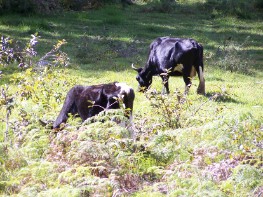
Holstein cows in a bracken infested field in Mérida, Venezuela. Note that pasture is very short, unable to provide animals nutritional demands. Soon enough cows will beging eating bracken leading to cases of bovine enzootic hematuria (BEH). BEH bleeding is caused by severe cystitis and urothelial cancer induced by ptaquiloside. The condition is lethal and there is no viable treatment.

Cow affected by severe bovine enzootic hematuria (BEH. Note the bleeding urine. This condition stems from pluricancer lesions in the urinary bladder wall and inner lining (urothelium). The pathology is well described in the veterinary literature but the relationship with bracken consumption was firmly established only recently. Photo from Zaruma, Ecuador.
Ptaquiloside induces cancer and other ailments such as bone marrow degradation and severe hematopoietic disorders depending on the consumer species. If bovines chiefly develop BEH after prolongued chronic exposure to brackens, rodents suffer from ileal, lung and mammary carcinomas. People at risk of bracken subacute intoxication is believed to develop stomach carcinomas but may require other cofactors for carncer to be epidemiologically signifficant.
PTAQUILOSIDE REACHING THE HUMAN DIET
Bracken croziers and/or rhizomes are considered a treat to relatively few people, chiefly in Asia. Maori in New Zealand, a few places in Brazil and Africa treat themselves with bracken parts as well. In remote and idyllic Bhutan (Himalaya), young croziers of Pteridium revolutum loaded with PTQ are a traditional staple. Not surprisingly, gastric cancer rates among these people are well above average.
But there are other routes for ptaquiloside to reach the human diet. The figure at right shows this in one shot. It is not only milk and meat, but water runoff from bracken stands is also a vehicle. Mind that this runoff might reach water catchments for municipal use. Interesting work by Lars Rasmussen, Hans CA Hansen in Denmark and others have discovered this worrisome feature. The reader can find these papers in Google Scholar or formal science databases easily.

Schematic flowchart of ptaquiloside course from bracken swards to people
Livestock exposed to bracken, a vastly common occurrence in many farms with sufficient moisture and relatively mild climate across the world, eat a significant portion of fronds. Some of bracken illudantes end up stored in meat while over 8% of ptaquiloside (PTQ) is excreted in milk, driving calves ill, as described earlier in this page. PTQ is greatly diluted when tainted milk is mixed with 'clean' milk along the production chain. However, farmers and small town folks like to drink raw milk straight from cows udder, as it was the healthiest elixir. WRONG. They get the ful impact of PTQ. GC rates go through the roof among these people.
Rain also drives PTQ in fronds to he ground. The details of this occurrence from the plant anatomy*physiology has not been looked at yet. We wish to look into this some day.
Once in the ground, PTQ is destroyed in part by soil microbiota, but some remains there probably in association with clay particles. It appears downstream in several micrograms per liter of water, according to Rasmussen and his companion researchers in Copenhage.
PTAQUILOSIDE, HELICOBACTER PYLORI AND GASTRIC CANCER

While incidence rates of gastric adenocarcinoma (GC) have been declining steadily in industrial societies, less technologically favored countries do not follow the same trend (>70% of cases worlwide). There is nearly one million GC cases diagnosed every year.
Incidence and death rates continue to be quite high in most of Asia, Africa and Latin America. Several lines of evidence associate GC with Helicobacter pylori (Hp) infection. The trouble is that seven to eight people in ten carry this bacterium in their stomachs but only 2 to 4 in 10.000 ever develop GC
In addition, the current opinion is that Hp by itself does not suffice to complete the complex tumorigenic sequence and seems to require other factors.
Singling out individual factors is a hard task if one realizes that the average person eats over 50 metric tons of solid food and more that 70 thousand L of water and beverages during his/her lifespan. All this matter carries a vast number of chemicals, some of which are reactive against DNA (genotoxic).
In fact, most people ignore that over 250 compounds of industrial origin, not to speak of natural toxicants or those derived from excess cooking temperature, can be detected in their blood, or in mother's milk for that matter. Most of these compounds got there through eating/drinking and a smaller quantity goes in by simply breathing. Hence, there is a lot of candidates to chose from at the time of accompanying Hp in its carcinogenic task.
The geographical distribution of GC rates provides some interestin leads. Among others, we observed that in South America the greater rates occurred among those living in mountain areas along the Andean sierra from Venezuela to Bolivia and Northern Argentina. There was a stark contrast in GC odds ratios between highlands and coastal or piedmont zones. The trend was broken though in Chile where rates are virtually the same in high terrain or lowland.
However, as far as Helicobacter pylori infection, the Northern and Southern Andes, including Chile, the rates are not significantly different in high ground or coastal zones (all 80+ among young adults). CagA, VacA and other virulent strains of H. pylori frequently associated with gastric cancer are common in all areas.
One startling fact is that, while bracken fern is a scourge of mountain plantations and pastures from Venezuela to Argentina, this fern is absent in Chile. The great Atacama desert and the massive Andean block of Bolivia may have been the natural barrier to bracken's expansion from the north.
This scenario creates an enticing link between bracken carcinogens, chiefly ptaquiloside, and H pylori. We developed this link into a detailed hypothesis, now just published:
A. Oliveros-Bastidas, M. P. Calcagno Pissarelli, M. Naya, J. L. Ávila Núñez, M. E. Alonso-Amelot. Human gastric cancer, Helicobacter pylori and bracken carcinogens: a connecting hypothesis. Medical Hypotheses, 2015;11: Abstract available at doi.org/10.1016/j.mehy.2015.11.007
The scheme below illustrates the combined dynamics of H. pylori and PTQ moving along the bacterium the piggyback way
(Copyrights of the published scheme are the editor's. An abridged figure is currently under construction and will show up soon.
BRACKEN TOXIC COMPONENTS AND ECOLOGY
Bracken ferns contain over 100 well recognized secondary metabolites, including sesquiterpenes (e.g. illudanes), a cyanogenic glycoside, several pterosins with an indanone nucleus, a number of flavonoids and their glycosides, a small amount of insect moulting hormone (ecdysone), alkaloids and other materials. These ferns also include a susbtantial body of phenolics and polyphenolics (proanthocyanidins) that accumulate in large quantity in fronds exposed to direct solar light. Most of these compounds show some degree of toxicity, from sparse to very toxic, making of bracken one of the most well chemicall defended plants.
In synthesizing and storing toxic compounds, plants face the problem of autotoxicity. To avoid this, plants have developed storage sites such as the vacuole, a large sac at the center of parenchymal cells. Here, biologically active compounds continue to perform their function despite their isolation from cytosol chemistry.
One good example is the phenolics/polyphenolics fraction, which is very abundant in bracken fronds.

Once bracken sturdy fronds complete their life cycle they remain standing as they decompose only very slowly. This creates a canopy of dead material on top of any emerging crozier. These must grow straight up until reaching the top of the dead canopy before pinnae can unravel sidewise, This phenomenon creates a two-tier microforest with dead vegetation in the lower stratum and fresh fronds in the upper level. The combination of these two components forms a dense thicket which excludes almost all other plant growth. Phenolic exhudates contributes to this inhibition.
THIS SITE CONTINUES UNDER CONSTRUCTION, LAST ADDITION: SEPTEMBER 2015